Commemoration D-Day: visit the historical sites
6 June, 2019 | Update: 10/05/2024
Normandy and D-Day are inextricably linked. In June 1944, the Allies chose the Normandy beaches for a historic military operation. Famous films and series like Band of Brothers, Saving Private Ryan and The Longest Day already tell you a lot about this event, but sometimes you need to have seen something with your own eyes to grasp it. I show you five historical sites that not only played an important role during D-Day, but are still very special to visit today.
D-Day always attracts extra attention in late May and early June. But you will also be reminded of D-Day in Normandy on any other day or time of year. The list of impressive sights is almost endless, but these five suggestions certainly do not disappoint.
- Caen: from a battered city to a modern metropolis
- Pointe du Hoc’s lunar landscape
- The floating harbours of Arromanches
- Historic drink at Café Gondrée
- Awareness in Colleville-sur-Mer and La Cambe
1. Caen: from a battered city to a modern metropolis
The city of Caen was one of the most important targets for the Allied Forces during the invasion. It was strategically important, particularly because of the River Orne and the Caen Canal. No wonder that the German army defended the city with every possible force. This resulted in the liberation of Caen not taking just one day as planned, but six weeks in total. The death toll was high: more than 30,000 British and Canadian troops were killed and another 3,000 civilians lost their lives.
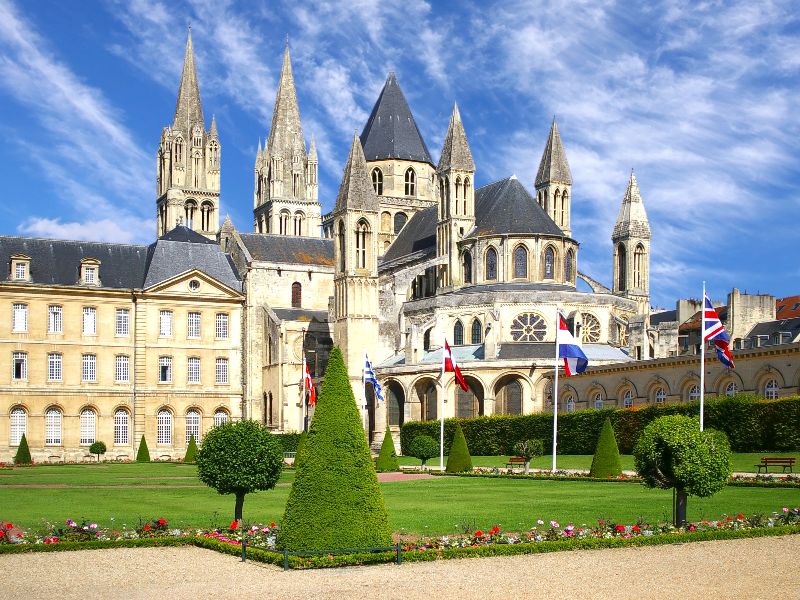
Caen has restored many historic buildings and has grown into a modern metropolis
You can learn all about the history of the war in the Mémorial de Caen Museum, which has been constructed on the spot that the underground commando bunker of the 716th German Infantry Division once occupied. But there is more to Caen than just the Second World War. Several historic buildings have been preserved and numerous others restored. Slowly but surely the city has developed into the modern metropolis it is today. History, culture and architecture now go hand in hand with plenty of greenery, culinary enjoyment and a lively city centre. It’s certainly worth a day trip during your holiday!
Campsite tip: Camping Château de Martragny
2. Pointe du Hoc’s lunar landscape
A thirty metre high cliff with a small pebble beach in front of it. German bunkers at the top of the cliff contained numerous canons which could open fire on the Utah Beach and Omaha Beach landing beaches. The risky assignment: to climb the cliff and disarm the guns. This is what awaited the American Rangers on 6 June 1944. By shooting mortars upwards, onto which ropes and rope ladders were attached, the troops managed to climb up the cliffs, disarm the enemy and take up strategic positions.
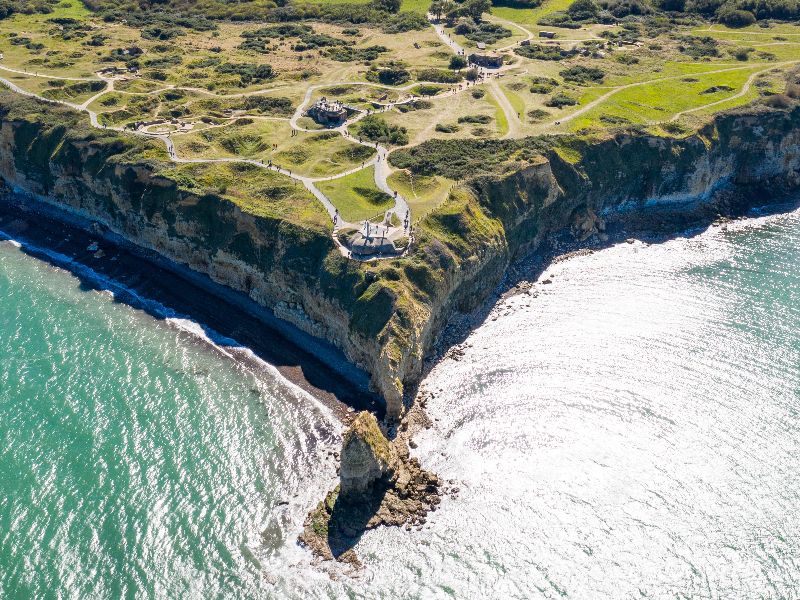
Pointe du Hoc from above: The craters in the landscape, caused by the bombing, are clearly visible
After the exhausting fighting, one more test faced the hundred or so remaining Rangers. They had to survive German counter attacks for several days without reinforcements and with quickly depleting rations. Amazingly they managed to do so and because of this it has become a memorable location. Pointe du Hoc is free to visit and resembles a lunar landscape with many deep craters and concrete bunkers. The Pointe du Hoc Federal Monument occupies the highest point on the cliff. The views from here are stunning!
Campsite tip: Camping Le Fanal
3. The floating harbours of Arromanches
The French resort of Arromanches-les-Bains, hidden away between several cliffs, is a haven of peace. Well it was until June 1944. The Allied Forces had in fact chosen this location for a unique and never previously tried operation: creating an enormous floating harbour. In their view the invasion would only succeed if they had their own harbour for transporting goods, troops and equipment. And so a floating harbour (the Mulberry Harbour) was constructed in record time just off the Arromanches coast.
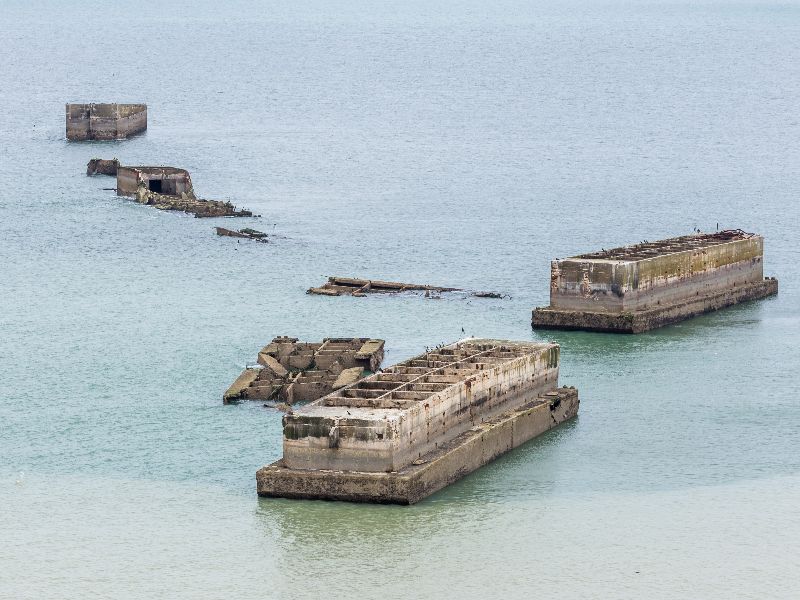
The remains of the Mulberry Harbour are still visible just off the coast at Arromanches
During the invasion more than 529,000 tons of goods were transported though this harbour, which was constructed from sunken ships and caissons: enormous concrete tanks which were sunk once they were in the right location. To really comprehend the enormity of this building work, you would have had to be there at the time. But you can still see the remains of them with your own eyes to this very day. And if you want to find out more about Arromanches and this unusual harbour, visit the Arromanches Museum 360 and watch a film about the Battle of Normandy on nine screens.
Campsite tip: Camping des Bords de l’Aure
4. Historic drink at Café Gondrée
Café Gondrée is right on the banks of Caen Canal, beside the famous Bénouville bridge (also known as Pegasus Bridge). What’s so unusual about this café? Well this was the first liberated house in Western Europe! British parachutists landed in the vicinity of this bridge just after midnight. They were quickly able to capture this important bridge over the canal. When the Gondrée family emerged from their air raid shelter the following morning, they stood face to face with the British soldiers.
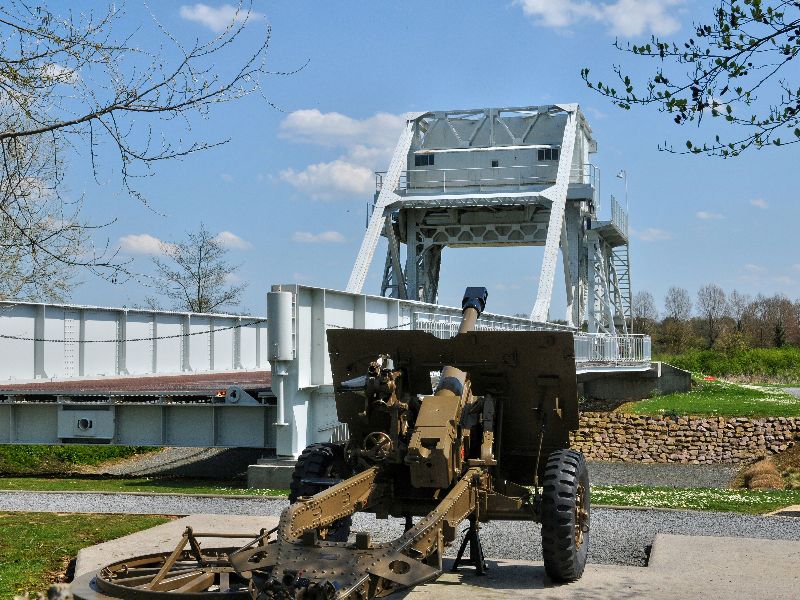
The original Bénouville Bridge, also known as Pegasus Bridge, has been preserved
As a renowned resistance fighter, Thérèse Gondrée could speak German and was able to listen to conversations between German soldiers which she could pass on to the resistance, and she greeted the liberators warmly. Her husband Georges had even buried bottles of champagne in 1940 to celebrate liberation day. He quickly unearthed the bottles and made sure that the British troops could come and drink for free. Descendants of the Gondrée family still uphold this tradition. British veterans who visit the region for the commemorations don’t have to pay for their drinks in the café. Tourists have to, of course, but what could be more unusual than to enjoy your drink in this historic place?!
Campsite tip: Camping Riva Bella – Marvilla parks
5. Awareness in Colleville-sur-Mer and La Cambe
The Battle of Normandy lasted until 29 August, the day that Paris was liberated. It claimed the lives of 425,000 victims on both sides and among the local population. The enormity of these numbers becomes apparent in Colleville-sur-Mer and La Cambe.
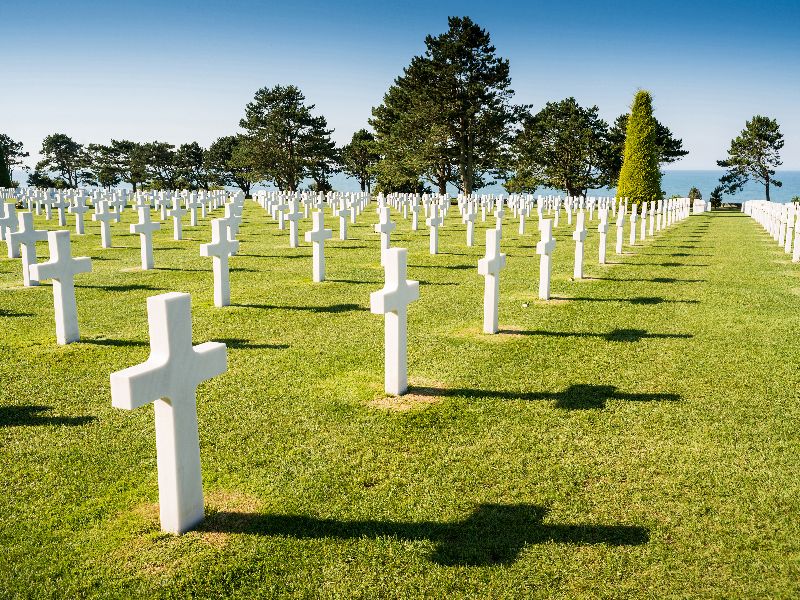
The impresive American Cemetery in Colleville-sur-Mer
The 70 hectare American Cemetery. is located in Colleville-sur-Mer. You can look across rows of white crosses that are positioned in endless straight lines. In total there are 9387 memorials here. Not surprisingly, the cemetery is close to Omaha Beach, where most of the American victims fell on the day of the invasion. About 15 km away, close to the village of La Cambe, is the most famous cemetery for German soldiers. It is more simple than the American cemetery, but with 21,200 graves it is no less impressive.
Campsite tip: Camping Le Picard
Your personal tips?
Have you ever been on a camping holiday in Normandy? Or have you travelled around in your motorhome and visited the historic spots that remind us of D-Day? I’m keen to hear which places you can recommend for a visit.


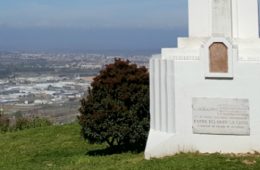
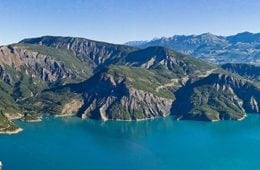
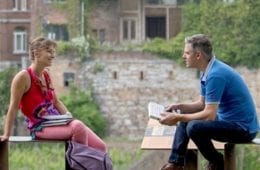





Latest comments